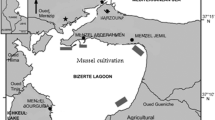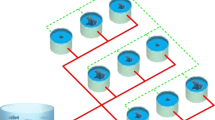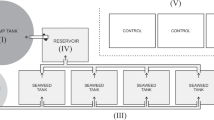Abstract
An increase in the use of macroalgal biomass for different applications is required in development of efficient cultivation systems and low-cost culture media. With this in mind, the present work proposes modifications to the Algal Turf Scrubber (ATS) system inducing the establishment of a monospecific culture of Ulva ohnoi through a seeding process, speeding up the maturation time and increasing efficiency and productivity. Bench-scale units of Seeded Algal Turf Scrubber (sATS) were built to test different types of algal attachment substrates (nylon and jute fiber) and water flow conditions (stagnant and continuous) besides evaluating of coverage rate, daily growth rate, and nutrient removal capacity. The results were promising. The coverage rate by U. ohnoi seedlings was higher when nylon substrate was combined with continuous water flow (74.41 ± 6.79%). Changes in nutrient concentration demonstrated a dose-dependent pattern with complete removal of P-PO43− in 24 h at all concentrations tested when the system had 18 days of maturation and N-NH4+ was completely removed in 24 h at all concentrations tested in both maturation times (18 and 47 days). Daily growth rates presented satisfactory values, reaching maximum of 4.8 ± 0.6% day−1. In conclusion, it was demonstrated that the bench-scale sATS system was successful to enable cultivation of U. ohnoi by seeding, resulting in good quality biomass production and efficient nutrient removal, thus justifying upscale experiments.







Similar content being viewed by others
References
Adey WH, Loveland K (2007) Dynamic Aquaria. Elsevier, Washington, D.C.
Adey WH, Luckett C, Smith M (1996) Purification of industrially contaminated groundwaters using controlled ecosystems. Ecol Eng 7:191–212
Agrawal SC (2009) Factors affecting spore germination in algae - review. Folia Microbiol 54:273–302
Ale MT, Mikkelsen JD, Meyer AS (2011) Differential growth response of Ulva lactuca to ammonium and nitrate assimilation. J Appl Phycol 23:345–351
Angell AR, Mata L, de Nys R, Paul NA (2014) Variation in amino acid content and its relationship to nitrogen content and growth rate in Ulva ohnoi (Chlorophyta). J Phycol 50:216–226
Barr N, Kloeppel A, Rees T, Scherer C, Taylor RB, Wenzel A (2008) Wave surge increases rates of growth and nutrient uptake in the green seaweed Ulva pertusa maintained at low bulk flow velocities. Aquat Biol 3:179–186
Bastos E, Gouvêa LP, Horta PA, Rörig LR (2019a) Interaction between salinity and phosphorus availability can influence seed production of Ulva ohnoi (Chlorophyta, Ulvales). Environ Exp Bot 167:103860
Bastos E, Schneider M, de Quadros DPC, Welz B, Batista MB, Horta PA, Rörig LR, Barufi JB (2019b) Phytoremediation potential of Ulva ohnoi (Chlorophyta): Influence of temperature and salinity on the uptake efficiency and toxicity of cadmium. Ecotoxicol Environ Saf 174:334–343
Bolton JJ, Robertson-Andersson DV, Shuuluka D, Kandjengo L (2009) Growing Ulva (Chlorophyta) in integrated systems as a commercial crop for abalone feed in South Africa: a SWOT analysis. J Appl Phycol 21:575–583
Callow ME, Callow JA, Ista LK, Coleman SE, Nolasco AC, López GP (2000) Use of self-assembled monolayers of different wettabilities to study surface selection and primary adhesion processes of green algal (Enteromorpha) zoospores. Appl Environ Microbiol 66:3249–3254
Castelar B, Reis RP, dos Santos Calheiros AC (2014) Ulva lactuca and U. flexuosa (Chlorophyta, Ulvophyceae) cultivation in Brazilian tropical waters: recruitment, growth, and ulvan yield. J Appl Phycol 26:1989–1999
Cohen I, Neori A (1991) Ulva lactuca biofilters for marine fishpond effluents. I. Ammonia uptake kinetics and nitrogen content. Bot Mar 34:475–482
Craggs RJ, Adey WH, Jessup BK, Oswald WJ (1996) A controlled stream mesocosm for tertiary treatment of sewage. Ecol Eng 6:149–169
FAO (2020) The State of World Fisheries and Aquaculture 2020. FAO, Rome
Figueira TA, da Silva AJR, Enrich-Prast A, Yoneshigue-Valentin Y, de Oliveira VP (2020) Structural characterization of ulvan polysaccharide from cultivated and collected Ulva fasciata (Chlorophyta). Adv Biosci Biotechnol 11:206–216
Froehlich HE, Afflerbach JC, Frazier M, Halpern BS (2019) blue growth potential to mitigate climate change through seaweed offsetting. Curr Biol 29:3087–3093
Geng H, Yan T, Zhou M, Liu Q (2015) Comparative study of the germination of Ulva prolifera gametes on various substrates. Estuar Coast Shelf Sci 163:89–95
Glasson CRK, Sims IM, Carnachan SM, de Nys R, Magnusson M (2017) A cascading biorefinery process targeting sulfated polysaccharides (ulvan) from Ulva ohnoi. Algal Res 27:383–391
Gouvêa LP, Assis J, Gurgel CFD, Serrão EA, Silveira TCL, Santos R, Duarte CM, Peres LMC, Carvalho VF, Batista M, Bastos E, Sissini MN, Horta PA (2020) Golden carbon of Sargassum forests revealed as an opportunity for climate change mitigation. Sci Total Environ 729:138745
Grasshoff K, Ehrhardt M, Kremling K (1983) Methods of seawater analysis, 2nd edn. Weinheim, New York
Hafting JT, Critchley AT, Cornish ML, Hubley SA, Archibald AF (2012) On-land cultivation of functional seaweed products for human usage. J Appl Phycol 24:385–392
Hernández I, Martínez-Aragon JF, Tovar A, Pérez-Lloréns JL, Vergara JJ (2002) Biofiltering efficiency in removal of dissolved nutrients by the three species of estuarine macroalgae with sea bass (Dicentrarchus labrax) waste waters 2. Ammonium. J Appl Phycol 14:375–384
Kim JK, Yarish C, Hwang EK, Park M, Kim Y (2017) Seaweed aquaculture: cultivation technologies, challenges and its ecosystem services. Algae 32:1–13
Koch EW (1993) The effect of water flow on photosynthetic processes of the alga Ulva lactuca L. Hydrobiologia 260–261:457–462
Lawton RJ, Mata L, de Nys R, Paul NA (2013) algal bioremediation of waste waters from land-based aquaculture using Ulva: selecting target species and strains. PLoS One 8:e77344
Li H, Zhang Y, Han X, Shi X, Rivkin RB, Legendre L (2016) Growth responses of Ulva prolifera to inorganic and organic nutrients: implications for macroalgal blooms in the southern Yellow Sea, China. Sci Rep 6:26498
Magnusson M, Mata L, de Nys R, Paul NA (2014) Biomass, lipid and fatty acid production in large-scale cultures of the marine macroalga Derbesia tenuissima (Chlorophyta). Mar Biotechnol 16:456–464
Marinho-Soriano E, Morales C, Moreira WSC (2002) Cultivation of Gracilaria (Rhodophyta) in shrimp pond effluents in Brazil. Aquac Res 33:1081–1086
Mata L, Magnusson M, Paul NA, de Nys R (2016) The intensive land-based production of the green seaweeds Derbesia tenuissima and Ulva ohnoi: biomass and bioproducts. J Appl Phycol 28:365–375
McHugh DJ (2003) A guide to the seaweed industry. FAO, Rome
Msuya FE, Neori A (2008) Effect of water aeration and nutrient load level on biomass yield, N uptake and protein content of the seaweed Ulva lactuca cultured in seawater tanks. J Appl Phycol 20:1021–1031
Mulbry WW, Wilkie AC (2001) Growth of benthic freshwater algae on dairy manures. J Appl Phycol 13:301–306
Neori A, Bronfman Y, van Rijn J, Guttman L, Krupnik N, Shpigel M, Samocha TM, Davis DA, Qiu X, Abelin P, Israel Á (2020) The suitability of Ulva fasciata, Ulva compressa, and Hypnea musciformis for production in an outdoor spray cultivation system, with respect to biomass yield and protein content. J Appl Phycol 32:3183–3197
Noemí Gil M, Ladran Torres A, Luis Esteves J (2005) Uptake of sewage derived nitrogen by Ulva rigida (Chlorophyceae) in Bahía Nueva (Golfo Nuevo, Patagonia, Argentine). Hydrobiologia 532:39–43
Ray NE, Terlizzi DE, Kangas PC (2015) Nitrogen and phosphorus removal by the Algal Turf Scrubber at an oyster aquaculture facility. Ecol Eng 78:27–32
Rorrer GL, Modrell J, Zhi C, Yoo H-D, Nagle DN, Gerwick WH (1995) Bioreactor seaweed cell culture for production of bioactive oxylipins. J Appl Phycol 187–198. https://doi.org/10.1007/BF00693067
Samanta AK, Mukhopadhyay A, Ghosh SK (2020) Processing of jute fibres and its applications. In: Kozlowski R, Mackiewicz-Talarczyk M (eds) Handbook of Natural Fibres, 2nd edn. Elsevier, Amsterdam, pp 49–120
Shpigel M, Guttman L, Ben-Ezra D, Yu J, Chen S (2019) Is Ulva sp. able to be an efficient biofilter for mariculture effluents? J Appl Phycol 31:2449–2459
Smit AJ, Robertson BL, Du Preez DR (1996) Influence of ammonium-N pulse concentrations and frequency, tank condition and nitrogen starvation on growth rate and biochemical composition of Gracilaria gracilis. J Appl Phycol 8:473–481
Sode S, Bruhn A, Balsby TJS, Larsen MM, Gotfredsen A, Rasmussen MB (2013) Bioremediation of reject water from anaerobically digested waste water sludge with macroalgae (Ulva lactuca, Chlorophyta). Bioresour Technol 146:426–435
Strickland JDH, Parsons TR (1972) A practical handbook of seawater analysis. Fisheries Research Board of Canada, Ottawa
Tanna B, Mishra A (2019) Nutraceutical potential of seaweed polysaccharides: structure, bioactivity, safety, and toxicity. Compr Rev Food Sci Food Saf 18:817–831
Titlyanov EA, Titlyanova TV (2010) Seaweed cultivation: methods and problems. Russ J Mar Biol 36:227–242
Tsagkamilis P, Danielidis D, Dring MJ, Katsaros C (2010) Removal of phosphate by the green seaweed Ulva lactuca in a small-scale sewage treatment plant (Ios Island, Aegean Sea, Greece). J Appl Phycol 22:331–339
Vairappan CS (2006) Seasonal occurrences of epiphytic algae on the commercially cultivated red alga Kappaphycus alvarezii (Solieriaceae, Gigartinales, Rhodophyta). J Appl Phycol 18:611–617
Wang J, Li X, Zhang C (2019) Recent advances on bioactivity of seaweed polysaccharides. Med Res 3:200003
Acknowledgements
We sincerely thank the Federal University of Santa Catarina (UFSC), especially the faculty members and technical staff of the Laboratory of Phycology (LAFIC), Multi-User Laboratory for Biological Studies (LAMEB), and Marine Mollusks Laboratory (LMM) for providing space and resources for this work. Financial resources and scholarships were provided by the Coordination of Superior Level Staff Improvement (CAPES), National Council for Scientific and Technological Development (CNPq), and Santa Catarina State Foundation for Research and Innovation Support (FAPESC). We also thank Samara Dumong Fadigas, Thais Favero Massocato, Luana Aimi, Carolina Mueller, and Melissa dos Santos for their support and assistance in carrying out experiments and data collection. This study is part of the MSc. dissertation of the first author to the UFSC Graduate Program in Oceanography, Santa Catarina, Brazil. Bastos thank Conselho Nacional de Desenvolvimento Científico e Tecnológico (CNPq) for the Postdoctoral fellowship (process nos. 151637/2020-2).
Author information
Authors and Affiliations
Corresponding author
Additional information
Publisher’s note
Springer Nature remains neutral with regard to jurisdictional claims in published maps and institutional affiliations.
Supplementary Information
ESM 1
(DOCX 381 kb)
Rights and permissions
About this article
Cite this article
Salvi, K.P., da Silva Oliveira, W., Horta, P.A. et al. A new model of Algal Turf Scrubber for bioremediation and biomass production using seaweed aquaculture principles. J Appl Phycol 33, 2577–2586 (2021). https://doi.org/10.1007/s10811-021-02430-2
Received:
Revised:
Accepted:
Published:
Issue Date:
DOI: https://doi.org/10.1007/s10811-021-02430-2




